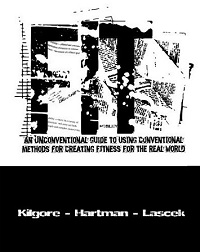That’s a 220 pound guy legitimately strict pressing 260 pounds overhead. For four. His knees don’t move and he’s not whipping his torso around. Impressive.
At USAPL Raw Nationals, AC had a shoulder tweak and was only able to bench 386 on his second attempt (at a 215ish body weight). In the meet write up, I said, “We’ll get the issue taken care of.”
Obviously the video above shows that we did. That and the fact that AC benched 405×2 on his final double recently. The major cue I gave him was to keep his elbows in on both movements (it maintains external rotation, distributes force across the triceps and anterior deltoid better therefore reducing stress on the A/C and glenohumeral joint, and allows for more efficient force application which makes a stronger press or bench). He’s also been using close grip bench as an assistance (I talk about the benefits and programming in The Texas Method: Advanced) as well as some direct triceps work (i.e. push-downs).
The reaction most people have to AC lifting is, “Wow! He’s a freak! I can never be like that!” There was a similar discussion a few weeks ago on /r/weightroom (here) about me. People think guys like AC, Chris, or even me are genetic freaks capable of unheard of feats. While we may lift well, it’s not because we have innate ability. It boils down to having an innate consistent and determined approach to training. All of my friends not only train with reckless intensity (with the exception of Brent who meanders to the barbell), but we aim to make our lifting, programming, and recovery better every day. I remember when AC pressed less than 185 and Chris deadlifted 440×5 — we are not genetic freaks. If anything, say that our obsession and focus is freakish.
At the same time it’s true that you may not ever get to press 260 for reps. That’s just reality. And it’s okay! If you started training in the last few years, most of us have many years on you. However, you shouldn’t gripe about it and feel like a bitch every time you go into the weight room. It’s okay that you’re squatting 230 while some fucking MASTODON is out there in the world doing his light volume work with 545 raw to full depth. We all start somewhere. Instead, decide to train your fucking dick off so that you can be the best at whatever your goal is.
There’s an amazing quote from The Lord of the Rings that had a profound effect on me when I first read the books in high school. Basically Frodo is bitching about the predicament they’re in and Gandalf lays down some Old Man Knowledge:
Frodo: “I wish none of this had happened.”
Gandalf: “So do all who live to see such times, but that is not for them to decide. All we have to decide is what to do with the time that is given to us.”
Being weak is definitely a disparaging situation. Are you going to let your weakness consume you, or are you gonna get up and find that fucking dog? Make a decision to not give a shit what other people are doing; we all start somewhere. Decide to be the best you can god damn be with what you have. God damn it.



